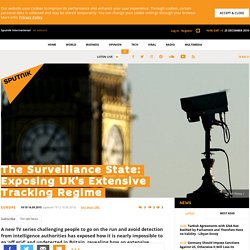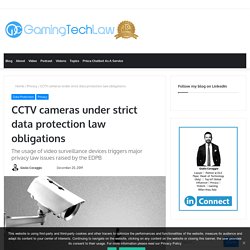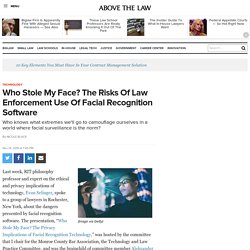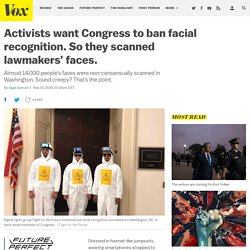

Experts: Spy used AI-generated face to connect with targets. LONDON (AP) — Katie Jones sure seemed plugged into Washington’s political scene.

The 30-something redhead boasted a job at a top think tank and a who’s-who network of pundits and experts, from the centrist Brookings Institution to the right-wing Heritage Foundation. She was connected to a deputy assistant secretary of state, a senior aide to a senator and the economist Paul Winfree, who is being considered for a seat on the Federal Reserve. But Katie Jones doesn’t exist, The Associated Press has determined.
The Surveillance State: Exposing UK's Extensive Tracking Regime. Europe 19:10 16.09.2015(updated 19:12 16.09.2015) Get short URL A new TV series challenging people to go on the run and avoid detection from intelligence authorities has exposed how it is nearly impossible to go ‘off grid’ and undetected in Britain, revealing how an extensive network of cameras, phones and cards make up the UK’s surveillance state.

CCTV cameras under strict data protection law obligations. CCTV cameras and in general, video surveillance systems are exponentially becoming intrusive but generate substantial data protection law issues according to the EDPB.

Updated on 20 December 2019 The European Data Protection Board (EDPB) issued guidelines on the processing of personal data through video devices that covers basic CCTV cameras merely collecting images. But the guidelines also apply to more invasive technologies such as smart cameras and devices, collecting biometric data whose operation shall be continuously reassessed because of the potential risks connected to their malfunctioning. The CJEU's recent judgment in TK.
Lorna Woods, Professor of Internet Law, University of Essex There is an increasing incidence of the use of video-surveillance and with it a need to find a framework in which the conflicting rights or those who are subject to such surveillance may be balanced.

While there is increasing case law surrounding state surveillance the position as regards private actors – beyond the fact that data protection laws may well apply – is less well-developed. The recent case of TK deals with such a balance, but the ruling of the Court of Justice is far from ground-breaking. The Facts. Biometric data collection by country: What's collected, how is it used? From passport photos to accessing bank accounts with fingerprints, the use of biometrics is growing at an exponential rate.

And while using your fingerprint may be easier than typing in a password, just how far is too far when it comes to biometric use, and what’s happening to your biometric data once it’s collected, especially where governments are concerned? Here at Comparitech, we’ve analyzed 50 different countries to find out where biometrics are being taken, what they’re being taken for, and how they’re being stored. While there is huge scope for biometric data collection, we have taken 5 key areas that apply to most countries (so as to offer a fair country-by-country comparison and to ensure the data is available). Each country has been scored out of 25, with high scores indicating extensive and invasive use of biometrics and/or surveillance and a low score demonstrating better restrictions and regulations regarding biometric use and surveillance. Key findings 5 Worst Countries 1. How fashion is fighting facial recognition technology. To combat the rise of facial-recognition technology, designers have created clothing and accessories that helps to conceal people's identities from A.I.Although some of these inventions appear to be effective, their main point seems to be to raise awareness about facial-recognition technology.In the U.S., surveys suggests that most Americans would oppose strictly limiting the government's ability to use facial-recognition technology.

Concerned about the rise of facial-recognition technology, some designers are creating fashion for a somewhat counterintuitive purpose: not to get noticed, at least by the cameras. In the Netherlands, Jip van Leeuwenstein designed a transparent "surveillance exclusion" mask that obfuscates a wearer's face to facial-recognition cameras but not other people. Image source: Jip van Leeuwenstein / HKU Design In Japan, Isao Echizen, a professor at the National Institute of Informatics in Tokyo, designed a "privacy visor" fitted with near-infrared LED lights.
ΔΠΜΣ εκδηλωση 5 12 19 αφισα. Beyond Orwell's Worst Nightmares: How China Uses Artificial Intelligence to Commit Genocide. Zarina Zabrisky translates the horrifying Russian reports from China of state surveillance, cruelty and murder of its minorities.

Who Stole My Face? The Risks Of Law Enforcement Use Of Facial Recognition Software. (Image via Getty) Last week, RIT philosophy professor and expert on the ethical and privacy implications of technology, Evan Selinger, spoke to a group of lawyers in Rochester, New York, about the dangers presented by facial recognition software.

The presentation, “Who Stole My Face? The Privacy Implications of Facial Recognition Technology,” was hosted by the committee that I chair for the Monroe County Bar Association, the Technology and Law Practice Committee, and was the brainchild of committee member Aleksander Nikolic, a Rochester IP attorney. Activists push Congress members to ban facial recognition surveillance. Dressed in hazmat-like jumpsuits, wearing smartphones strapped to their heads, the activists who descended upon Congress on Thursday were a strange sight.

They were there to scan faces: members of Congress, journalists, and whoever else happened to cross their path in the Capitol Hill area of Washington, DC. They also headed to K Street in hopes of finding Amazon lobbyists to scan. Using Rekognition, Amazon’s commercially available facial recognition software, the activists scanned nearly 14,000 faces, which they cross-checked with a database that enables the people to be identified. They livestreamed the whole process. The activists were not trying to be creepy for creepiness’s sake. The activists have one demand: the technology should be banned. The Rekognition system correctly identified one lawmaker, Rep. Www.vox.